

As an important symbol of Chinese civilization, the Grand Canal connects a north-south economic zone and cultural tie, carrying and witnessing the inheritance and innovation of Chinese civilization.As the cradle that gave birth to the Grand Canal, Jiangsu has the longest history of being nourished by the canal.In the long-term historical accumulation, with its specific geographical, human environment and beauties of literature, it links Wu culture, Huaiyang culture, Chuhan culture and Jianghai culture, giving birth to a brilliant Jiangsu in Chinese culture.The 8 cities along the Jiangsu section of the Grand Canal have formed a unified and distinctive canal culture under the nourishment of the Grand Canal.
Yangzhou "The origin of the canal, elegance of Yangzhou"
Yangzhou is the earliest in the world and the only "Canal City" of the same age as the Grand Canal in China."Many gardens are houses, and there are fewer carriages and horses than boats" truly reflects the prosperous scenery of this cosmopolitan city during the Sui, Tang, Ming and Qing Dynasties. "The green city is Yangzhou." Every plant, tree, and pavilion in Yangzhou show a delicate feeling to people.Whether it is the reputation of "Three famous knives in Yangzhou", or the legend of "Drinking tea in the morning and taking a shower in the evening", they all tell the development of the commercial culture and the fine consumer culture brought by the canal.The salt merchant culture, food culture, garden culture, and craft culture brought by the Grand Canal gave birth to the urban characteristics of "humanity, ecology, and refinement" in Yangzhou.
No matter Jianzhen traveled to Japan to spread Buddhism and culture, or Cui Zhiyuan came to Yangzhou as an official and brought Chinese culture back to North Korea, it is called the "Father of Eastern Culture".No matter it was Japan sending officer to study in China, or Marco Polo taking office in Yangzhou and other places, and then writing the book of "Marco Polo's Travels", they all brought Chinese culture to all parts of the world and expanded China's influence on the world.No matter it was master Faxian traveling to west for Buddha dharma, or the Arab prince Puhaddin who settled in Yangzhou to spread Islam, they spread the culture from outside the region to China and enriched the connotation of Jiangsu Canal culture.
Yuan Dynasty, Blue glaze plum vase with white dragon pattern
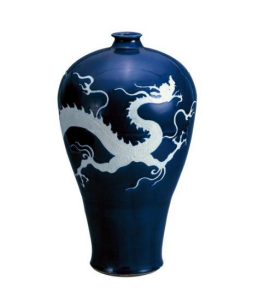
Yuan Dynasty, Blue glaze plum vase with white dragon pattern
Height 43.5, caliber 5.5, base diameter 14 cm
Collection of Yangzhou Museum Acquired from Yangzhou Cultural Relics Store in 1984
The plum vase has a small mouth, a short neck, and ample shoulders. Gradually converge below the shoulders, and move slightly outside near the bottom. The shallow bottom is concave. The whole body is covered with blue glaze, and dragon is covered with white glaze. The two glaze colors have a sharp and strong contrast.The main pattern is carved with a dragon chasing a flame orb, and is lined with four flame-shaped clouds. The mighty, majestic, and fierce dragon, flying in the blue sky, is quite powerful.
Among the three plum vases of Yuan dynasty with white dragon pattern collected at home and abroad, this vase is the largest and beautiful in shape, clean glaze, exquisitely decorated and lively, and majestic. It is the best product in the plum vase.
Qing Dynasty, "Orchid, Bamboo and Rock" scroll painting by Zheng Xie
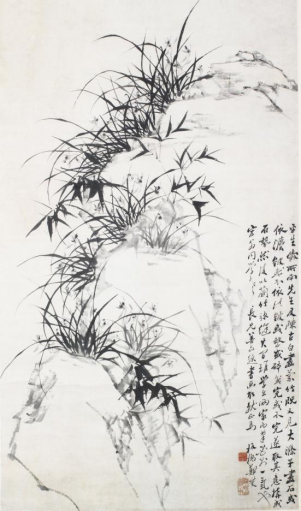
Qing Dynasty, "Orchid, Bamboo and Rock" scroll painting by Zheng Xie
.Length 178 cm, width 102 cm
Yangzhou Museum Collection
Zheng Xie (1693~1765), styled word Kerou, named Banqiao, was born in Xinghua, Jiangsu, and was a scholar of Kangxi by the imperial examination. Juren in the tenth year of Yongzheng (1732), Jinshi in the first year of Qianlong (1736).Officials in Fanxian and Weixian, Shandong Province. Before and after becoming an official, he lived in Yangzhou and made a living by painting and calligraphy. He is good at painting orchids, bamboos, stones, pine, etc., crafts calligraphy, mixed into the regular script with Bafen style, and claims to be "six and a half writing". And integrate the calligraphy into the painting. One of the "Eight Monsters of Yangzhou".
The composition of this work is simple, with the stone as the vein, and the scattered clusters of orchids and bamboo are organically integrated, which is both strict and changeable. It has a noble,vulgar, and natural feeling. The technique is vigorous and the orchids and bamboos are well-spaced and dense, and the shades are suitable. It is a boutique of Banqiao orchids and bamboos.
Tang Dynasty• The golden comb with the pattern of flying to the sky with music playing

Tang Dynasty• The golden comb with the pattern of flying to the sky with music playing
Height 12.5, width 14.5, thickness 0.04 cm
Collection of Yangzhou Museum Unearthed from the construction site of Sanyuan Road, Yangzhou City
The golden comb is a headware, which is hollowed out and carved with thin gold pieces in horseshoe shape with comb-shaped lower part.The upper part of the comb surface is fully decorated with patterns, and the main pattern in the center is made of cirrus-like floral tendril pattern, and the upper part is decorated with two symmetrical flying to the sky with music playing. Below the flying sky is decorated with a Ruyi moire.The periphery is decorated with multiple patterns, such as single-phase lotus petal pattern belt, double-thread clip lotus bead pattern belt, hollow fish scale pattern belt, hollow plum blossom butterfly pattern belt, etc.
Tang Dynasty, Celadon-glazed Pot with Brown-Green Dot-Colored Moire
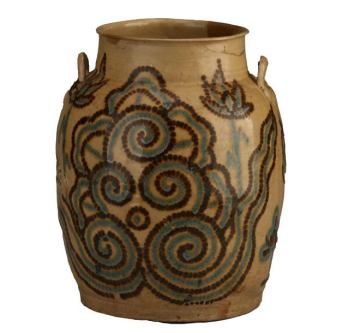
Tang Dynasty, Celadon-glazed Pot with Brown-Green Dot-Colored Moire
Height 29.8, caliber 16.3, base diameter 19.5 cm
Collection of Yangzhou Museum Unearthed from Tangcheng Site in Yangzhou City
The pot has a straight mouth, curled lips, high neck, puffed abdomen, and flat bottom. The shoulders are set with a symmetrical flat rings, decorated with moire and character "Wang". The whole body is covered with blue-yellow glaze and patterns.A bead-like cirrus cloud pattern is formed with large and small brown and green spots, each group is painted with lotus leaves and lotus patterns . Its large body, fine ornamentation, and beautiful glaze color are rare treasures in Changsha kilns.
Tang Dynasty, Blue and White Plate with Flower Pattern

Tang Dynasty, Blue and White Plate with Flower Pattern
Caliber 14.8, base diameter 6.9, height 3.3 cm
Collection of Yangzhou Museum Unearthed from the second phase of Wanjiafu project in Yangzhou
The four-petal flower-shaped mouth is splayed outwards, with shallow abdomen, and ringed feet. In the center of the plate, a four-petal flower pattern is painted in blue and white, and three groups of petal patterns are equally divided on the surface. White glaze is applied on the inside and outside of the plate. The plate is beige in color, fine and dense. This blue and white ware of Tang dynasty is well-shaped, neatly painted, and clear in layers. It is very rare.
The Western Han Dynasty, Cicada-Shaped Jade Han
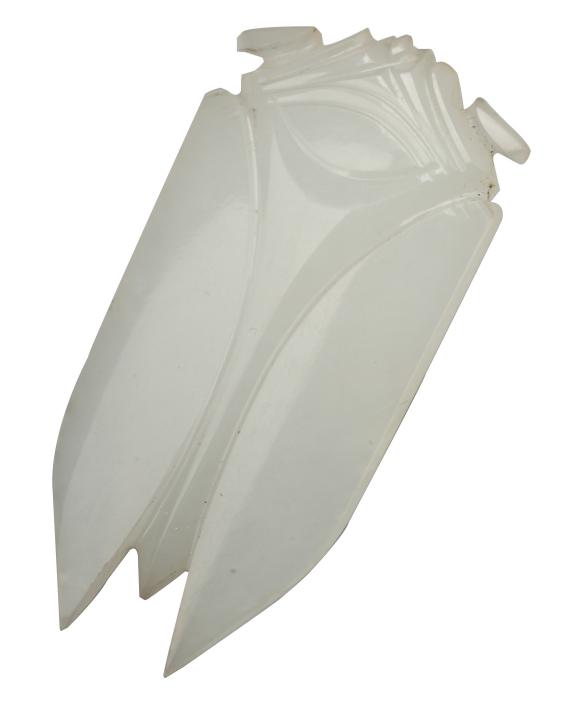
The Western Han Dynasty,Cicada-Shaped Jade Han
Length 5.7 cm, width 2.9 cm
Collection of Yangzhou Museum Unearthed from the Western Han Wooden Coffin Tomb in Yaozhuang, Ganquan Township, Hanjiang County
Jade han is in the shape of a cicada and is carved from Xinjiang Hetian jade. It is white and flawless, with lustrous light and strong transparency. The head of the cicada is slightly curved, the eyes are prominent, the corners of the mouth are distinct, and Cicada body is covered with the arc-shaped wings.The cicada's abdomen is engraved with twelve arc-shaped concave horizontal stripes, showing the cicada's telescopic abdominal segment. The cicada's craftsmanship is extremely sophisticated, and the lines are refined, smooth, and straight. The modeling is accurate and lifelike, reflecting the profound knowledge of jade carving skills in the Han Dynasty.
Han is a jade for ancient bury, usually in the shape of a cicada and held in the mouth of the deceased. The ancients believed that jade was the essence of mountains and rivers. It was placed in people's mouth, so that people's essence would not leak out, and the corpse would not rot. They hoped that after death, they would be as noble and transformed as a cicada in order to regenerate in the next life.
Eastern Han Dynasty, Evil-shielding Jade Pot
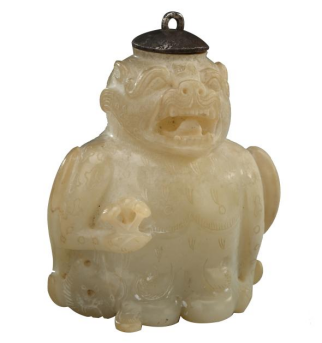
Eastern Han Dynasty, Evil-shielding Jade Pot
Overall height 7.7, pot height 6.8, width 6, and thickness 4.5 cm
Collection of Yangzhou Museum Unearthed from the Eastern Han Tomb at Tiger Dun, Ganquan, Hanjiang
It is made of Xinjiang Hetian white jade. The shape is a kneeling seat to ward off evil spirits. The right hand is holding the Ganoderma lucidum grass, the middle part is hollowed out, the top of the head has a round mouth, and the silver cover is placed on the top. The body is engraved with fine circle patterns and feather patterns, which integrates round carving, hollowing, relief, and Yin line fine carving techniques. It is a masterpiece of jade in the Eastern Han Dynasty.
Tang Dynasty, Bronze mirror with playing polo pattern

Tang Dynasty, Bronze mirror with playing polo pattern
18.5 in diameter and 1.0 cm thick
Collection of Yangzhou Museum Unearthed from the Jinwanba site in Tai'an, Hanjiang
The mirror is in the shape of a rhombus, and the back of the mirror is decorated with four knights,who are holding a ball rod in hand, playing polo on the horse.Between the people and the ball, there is a pattern of mountains and flowers, showing the scene of the game in the suburban sports field.The sport of polo originated from Persia and was introduced to China in the Han Dynasty. In the Tang Dynasty, the sport was very active and was loved by emperors and nobles. It was a theme in the decoration of bronze mirrors.At present, there are only three bronze mirrors related to playing polo in China. One is a handed down from the Palace Museum and the other is in the collection of Huaining County Museum in Anhui. The bronze mirror unearthed in Yangzhou is the best preserved, and it is a treasure of the Tang Mirror.
Ming Dynasty, Rhinoceros Horn Cup with model of Fairy traveling on the raft

Ming Dynasty, Rhinoceros Horn Cup with model of Fairy traveling on the raft
Height 8.6, length 26.5 cm, weight 261.5 grams
Collection of Yangzhou Museum Donated by Yangzhou Welfare Company
A high-quality rhino horn was selected by the sculptor. Based on the fairy tale of a fairy who reached Tianhe by raft in the sky, it is carved into a tree-chamber-shaped flat boat with the natural shape of the rhino horn.With the horn root as the raft tail and the horn tip as the raft head, there is a circular flow hole at the horn tip. The body and the bottom of the horn surround the embossed flowing water pattern. At the inner end of the raft, there is an old man sitting with his back on the rockery and wood, and looks happy. The artist uses a combination of round carving, open carving, relief carving and shallow carving to make the whole work rich in layers. It is not only an excellent handicraft, but also a kind of cooling, detoxifying and practical wine utensils.
Qing Dynasty, Block Carving of "Guyi Series"

Qing Dynasty, Block Carving of "Guyi Series"
Yangzhou Museum Collection
The block Carvingis wide, with different layouts, and exquisite writing and engraving, which is very precious."Guyi Series" was compiled by Li Shuchang, a famous scholar and diplomat in the late Qing Dynasty.Many of the books collected in this book are from China but lost in the local area for a long time. There are also a variety of Sui and Tang manuscripts and Song and Yuan engravings that are rare in the east neighbor collection, as well as the Chinese classics and other books of the Japanese ji jue. It occupies a prominent position in the history of Sino-Japanese classics exchange.
Qing Dynasty, White Jade Sheep
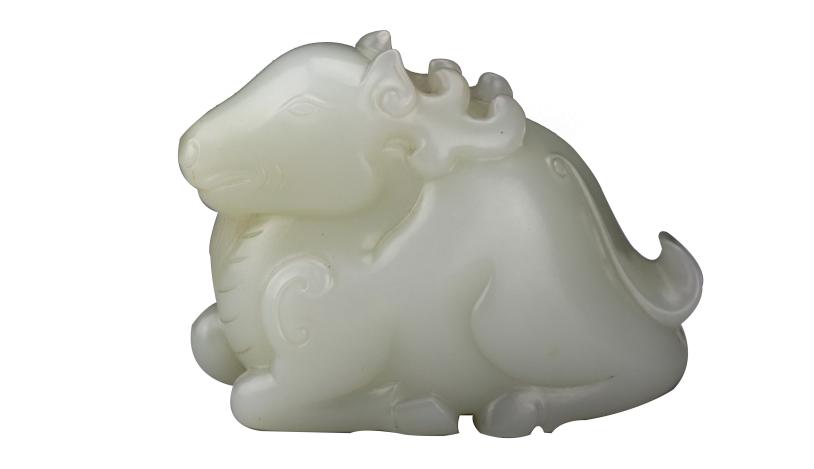
Qing Dynasty, White Jade Sheep
Yangzhou Museum Collection
The white jade sheep is in a lying posture, with bifurcated horn, looking up straight, in a calm expression. The facial features adopt the technique of shallow engraving. There is a slender moustache on the lower jaw. There is an engraved blue painted "Qianlong reign", this sheep is exquisitely crafted, the jade is gentle, and the lines are smooth and natural.
Qing Dynasty, "Prosperity at Canal" by Wang Su
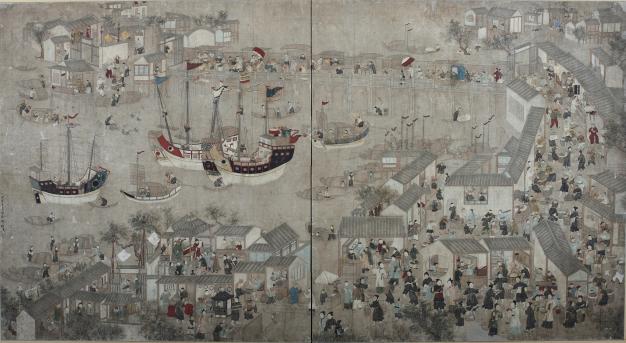
Qing Dynasty, "Prosperity at Canal" by Wang Su
Length 94 cm, width 174 cm
Yangzhou Museum Collection
The calligraphy and painting works of Wang Su, a native of Yangzhou in the Qing Dynasty, truly record the customs of the city on both sides of the Yangzhou Canal in the Qing Dynasty, and fully reflect the prosperous water transport in the Qing Dynasty. The painting depicts the customs of the Shaobo Canal in Yangzhou in the Qing Dynasty. There are boats in the river, and on the banks of the river there are all kinds of market life. Some people sell food and fish. There are people who eat noodles,eat steamed buns, sing operas, and perform folk juggling.
Tang Dynasty, Three-colour-glazed pillow with rhinoceros shape

Tang Dynasty, Three-colour-glazed pillow with rhinoceros shape
Height 7.5, length 11.2, width 8.4 cm
Collection of Yangzhou Museum, excavated from the construction site of Yangzhou Institute of Education
The pillow surface is rectangular, with a slight arc concave. A pair of butterflies flying in the same direction is engraved in the middle, and the edges are engraved with a circle. The pillow seat is a creeping rhino lying on the support.The rhinoceros has bulging eyes, big nose, wide mouth, and small ears. There is a small horn on the nose, a big horn on the top of the head, a stubby neck, four legs bent under the abdomen, and a long tail close to the body. Hair is engraved on the head, and fish scales are engraved all over the body.The glaze is bright and natural with full of yellow, green and brown colors. There are three burn marks on the nail pads.
Rhino is an animal that lives in the tropics. It is huge, strong, fierce, and weird in appearance. Rhino horn is a precious medicinal material. The owner of this pillow hopes that using the pillow can drive away diseases and avoid evil spirits, and be healthy.
Tang Dynasty, White Glazed Brown Figure Bullock-cart
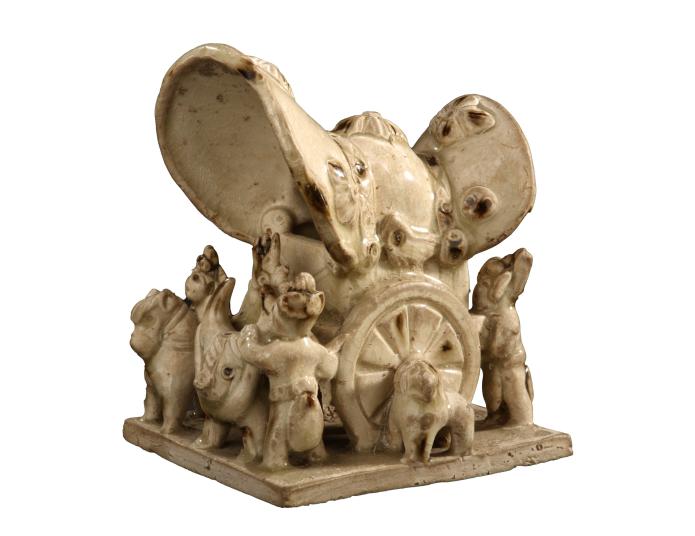
Tang Dynasty, White Glazed Brown Figure Bullock-cart
Height 11.5, base length 9.1, width 8 cm
Collection of Yangzhou Museum, excavated from Xuezhuang, Niansiqiao, Yangzhou
The bullock-cart has two wheels, square container, waist arc top high canopy, decorated with precious flowers, and belt.A lady with a high-bun hairpin is sitting inside the cart. A rider is standing in the front with his left stand holding the horn. A waiter on horseback with an arrow is standing on the right side. There are two servants at the rear of the cart and a small dog on each side of the wheel.The slash and vertical lines are engraved on the container for decoration. It is white and delicate, covered with blue and white glaze, crystal glaze and ice cracks.
Tang Dynasty, White Glazed Pot
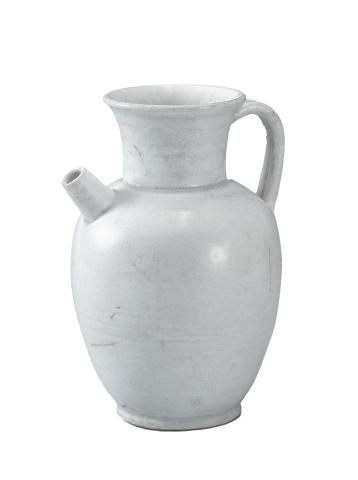
Tang Dynasty, White Glazed Pot
Height 17.3, mouth diameter 7.5, base diameter 6.4 cm
Collection of Yangzhou Museum Unearthed from Yangzhou Dongfeng Brick and Tile Factory
The pot has a flared mouth, a high neck, oblique shoulders, and an oblong abdomen. The lower part of the abdomen gradually converges. The pie-shaped feet have a flat bottom. A compound ring handle is placed between the neck and shoulders.The pot are firm with a dignified shape. Between the body and the white glaze, a body-protecting glaze is applied. This pot is a fine product of Xing kiln in Hebei Province.
Tang Dynasty, Celadon-glazed Green Arabic Flat Pot
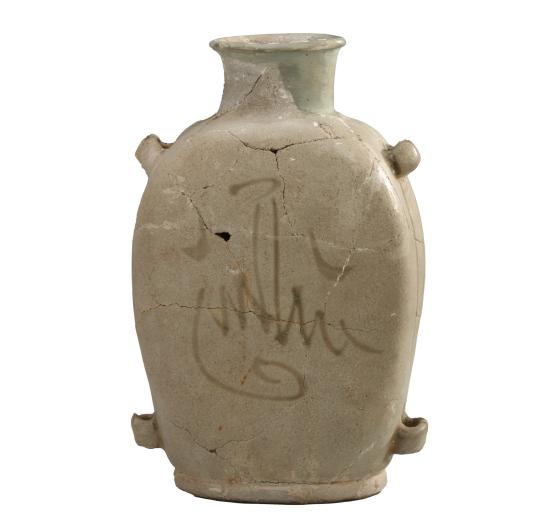
Tang Dynasty, Celadon-glazed Green Arabic Flat Pot
Height 17, mouth diamemter 6 cm
Yangzhou Museum Collection Unearthed from the Tang Dynasty Tukeng Wooden Coffin Tomb of Yangzhou Dongfeng Brick and Tile Factory
The pot has a slightly pointed lip, straight neck, slippery shoulders, the olive-shaped flat abdomen, and flat bottom. There are two ears on both sides of the body, which are used for carrying water on the back.The whole body of the pot is covered with cyan glaze, one side is painted with long-legged flowers and clouds, and the other side is written with the ancient Arabic inscription "Allah is the greatest" in green color.The shape, inscriptions and patterns of this pot have a strong West Asian style, and the pot is produced in a Changsha kiln in China. This is an important item that reflects the combination of Chinese and Western cultures in the Tang Dynasty.
Tang Dynasty, Green glaze Dragon-patterned Cup
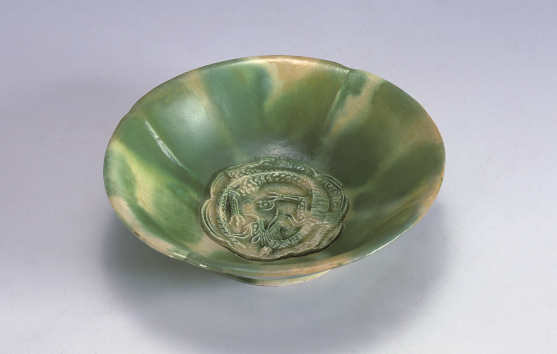
Tang Dynasty, Green glaze Dragon-patterned Cup
Height 4.3, mouth diameter 14.6, base diameter 6.9 cm
Collection of Yangzhou Museum Unearthed at Sanyuan Road, Yangzhou City
The cup is in the shape of a four-petal sunflower, with an extravagant mouth edge, an oblique arc abdomen, and the circle feet outside. There are two concave string patterns on the outer abdomen and the foot center. The center of the cup is piled up with a dragon. The dragon has a pointed beak, a scaled armor, four claws stretched out, and a short tail under the belly. The dragon's body is decorated with cloud patterns. The whole body is glazed, green and white, the enamel is crystal clear, and the color is bright and harmonious. It is a rare art work made in the kiln of Gongxian County, Henan Province.

The “Beautiful Hebei” Hebei Culture and Tourism (The Netherlands) Exhibition and Exchange Event

Supported by the China National Arts Fund, the International Touring Exhibition of Contemporary Chinese Paper-Based Art will be held from October 10 t...
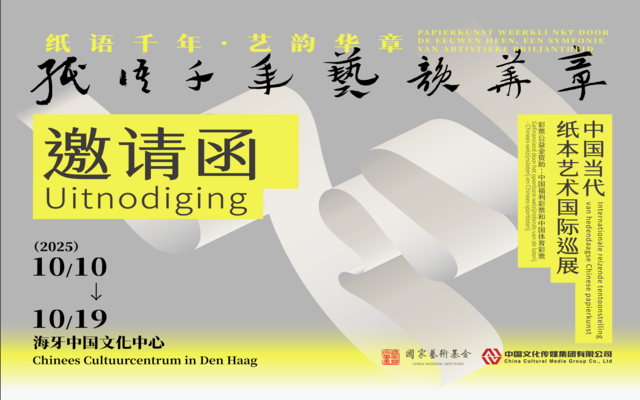
The China Cultural Center in The Hague warmly invites you to the opening of our upcoming exhibition
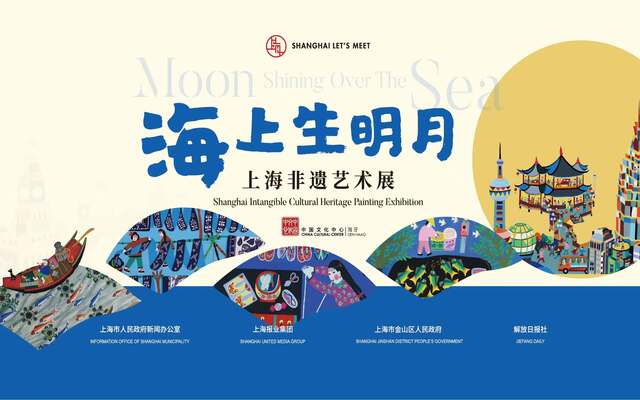
© 2023 China Cultural Center in Den Haag | Privacy policy